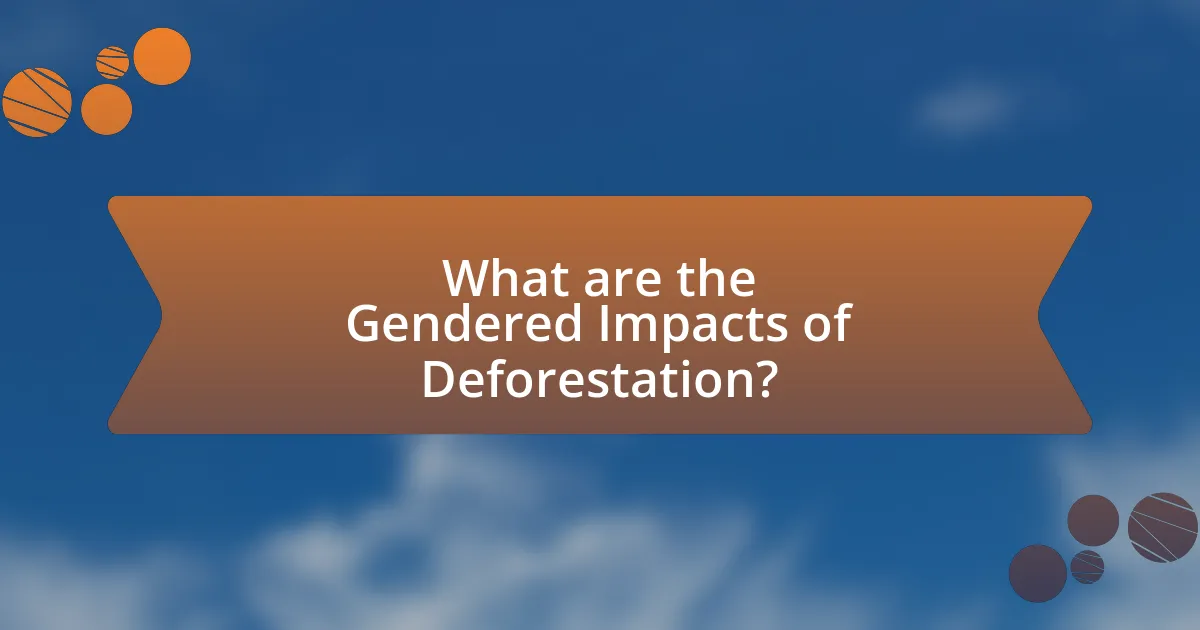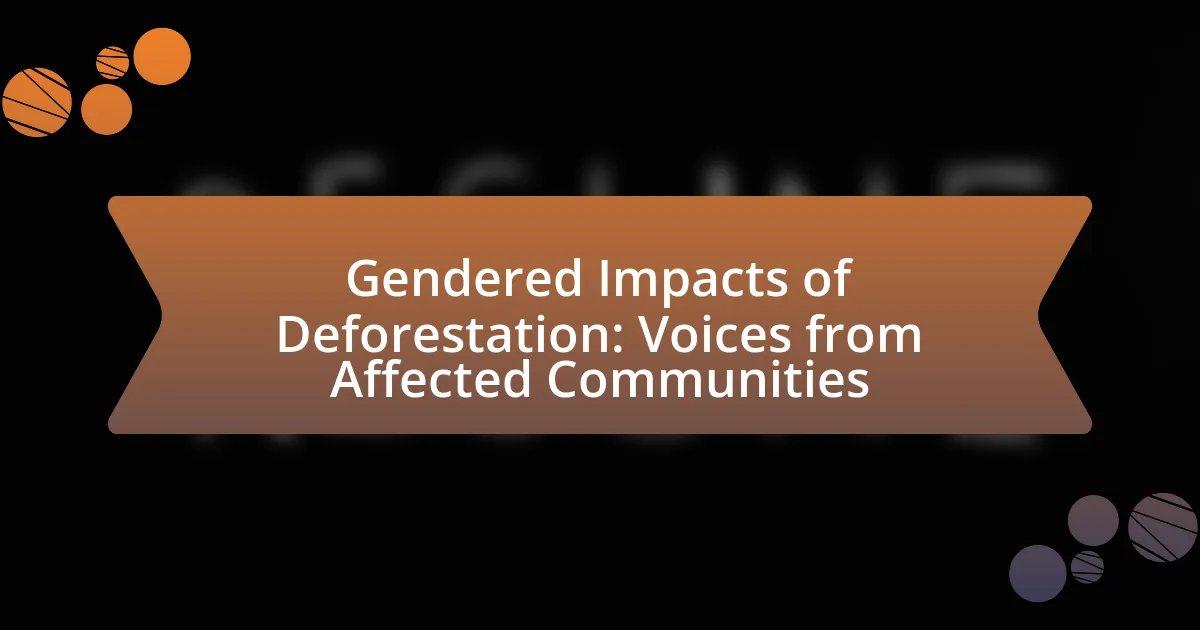The article “Gendered Impacts of Deforestation: Voices from Affected Communities” examines how deforestation disproportionately affects women compared to men, highlighting their reliance on forests for livelihoods and the subsequent increase in their workloads and vulnerability. It discusses the distinct roles of men and women in resource management, the economic dependencies that differ by gender, and the social consequences of deforestation on family dynamics and health. The article emphasizes the importance of women’s involvement in forest management and the need for gender-sensitive policies to address the unique challenges faced by women in deforested areas. Additionally, it explores how affected communities voice their experiences and propose solutions to mitigate the gendered impacts of deforestation.

What are the Gendered Impacts of Deforestation?
Deforestation has distinct gendered impacts, primarily affecting women more severely than men. Women often rely on forests for their livelihoods, including food, fuel, and medicinal resources, making them particularly vulnerable to the loss of these resources. Research indicates that in many communities, women are responsible for gathering food and fuel, and when forests are depleted, their workload increases, leading to greater time poverty and reduced access to education and healthcare. Furthermore, deforestation can exacerbate gender inequalities by limiting women’s economic opportunities and increasing their dependence on men for resources. Studies, such as those conducted by the Food and Agriculture Organization, highlight that women’s roles in forest management and conservation are often overlooked, despite their critical contributions to sustainable practices.
How does deforestation affect men and women differently?
Deforestation affects men and women differently primarily due to their distinct roles in resource management and economic activities. Men often engage in logging and agricultural expansion, which can lead to immediate economic benefits but also contribute to environmental degradation. In contrast, women typically rely on forests for subsistence activities such as gathering food, fuel, and medicinal plants, making them more vulnerable to the loss of these resources. Research indicates that when forests are depleted, women face increased workloads and reduced access to essential resources, which can exacerbate gender inequalities. For instance, a study by the Food and Agriculture Organization highlights that women in rural areas are disproportionately affected by deforestation, as they are often responsible for household sustenance and health, leading to negative impacts on their well-being and economic stability.
What specific roles do men and women play in forest management?
Men and women play distinct yet complementary roles in forest management. Men typically engage in activities such as logging, land clearing, and commercial timber production, often focusing on larger-scale operations. In contrast, women are primarily involved in the collection of non-timber forest products, such as fruits, nuts, and medicinal plants, and they often manage household-level forest resources. Research indicates that women contribute significantly to forest conservation and sustainable practices, as they possess traditional ecological knowledge that supports biodiversity. For instance, a study by the Food and Agriculture Organization highlights that women’s involvement in forest management can lead to improved resource sustainability and community resilience.
How do economic dependencies differ between genders in affected communities?
Economic dependencies in affected communities often differ significantly between genders, with women typically relying more on subsistence activities and informal economies, while men are more engaged in formal employment and resource extraction. For instance, research indicates that women in deforested areas often depend on forest resources for their livelihoods, such as gathering firewood and non-timber forest products, which are crucial for household sustenance. In contrast, men are frequently involved in logging and agricultural activities that generate cash income. This disparity is evidenced by a study conducted by the Food and Agriculture Organization, which found that women contribute up to 60% of the labor in agricultural production but have limited access to land and financial resources, reinforcing their economic vulnerability compared to men.
What are the social consequences of deforestation on gender roles?
Deforestation significantly alters gender roles within affected communities by exacerbating existing inequalities and shifting responsibilities. As forests are cleared, women often bear the brunt of increased labor demands, such as sourcing water and fuel, which were previously accessible within forested areas. This shift can lead to a reduction in women’s time for education and economic activities, reinforcing traditional gender roles that prioritize domestic responsibilities over personal development. Research indicates that in many regions, women are responsible for up to 80% of household water collection, a task made more difficult by deforestation, which can increase the distance to water sources (UN Women, 2020). Consequently, the social consequences of deforestation on gender roles include heightened workloads for women, limited access to resources, and a perpetuation of gender-based disparities in education and economic opportunities.
How does deforestation influence traditional gender roles in communities?
Deforestation significantly alters traditional gender roles in communities by shifting responsibilities and access to resources. As forests are cleared, women often face increased burdens in securing food, water, and fuel, traditionally sourced from forested areas. This shift can lead to a reallocation of roles, where women take on more labor-intensive tasks, while men may migrate to urban areas for work, thereby reinforcing gender disparities. Research indicates that in many communities, women are primarily responsible for household sustenance, and deforestation exacerbates their workload, limiting their economic opportunities and decision-making power. For instance, a study by the Food and Agriculture Organization highlights that women in deforested regions experience a 20% increase in time spent on resource collection, impacting their health and social status.
What changes occur in family dynamics due to deforestation?
Deforestation significantly alters family dynamics by increasing economic stress and shifting gender roles within households. As forests are depleted, families often lose access to resources such as food, fuel, and income derived from forest products, leading to heightened financial strain. This economic pressure can force family members, particularly men, to migrate for work, disrupting traditional family structures and responsibilities.
Moreover, women frequently take on additional roles, such as becoming primary caregivers and providers, which can lead to increased workloads and stress. Research indicates that in many communities, women are responsible for gathering food and water, tasks that become more challenging as deforestation progresses. For instance, a study by the World Resources Institute highlights that women in deforested areas spend significantly more time collecting resources, impacting their health and social roles.
These changes in family dynamics reflect broader societal shifts, where traditional roles are challenged, and new responsibilities emerge due to the environmental and economic impacts of deforestation.
What are the health impacts of deforestation on different genders?
Deforestation has distinct health impacts on different genders, primarily due to varying roles and responsibilities in affected communities. Women often experience increased health risks related to water scarcity and food insecurity, as they are typically responsible for water collection and food preparation. For instance, studies indicate that women in deforested areas face higher rates of malnutrition and related health issues due to reduced access to diverse food sources. Conversely, men may experience health impacts linked to increased exposure to environmental hazards, such as respiratory issues from burning biomass for fuel, which is more common in male-dominated labor sectors. Research shows that men in these regions report higher incidences of respiratory diseases, highlighting the gender-specific health challenges posed by deforestation.
How does access to healthcare change for men and women post-deforestation?
Access to healthcare for men and women changes post-deforestation by becoming more limited and inequitable. Deforestation often leads to the displacement of communities, which disrupts existing healthcare systems and reduces access to medical facilities. Women, who typically bear the burden of caregiving, may face increased challenges in accessing healthcare due to longer travel distances and reduced availability of services. Additionally, men may experience heightened health risks from environmental degradation, such as respiratory issues from increased air pollution. Studies indicate that in regions affected by deforestation, women report higher rates of unmet healthcare needs compared to men, highlighting the gendered disparities that arise in such contexts.
What are the mental health implications for women affected by deforestation?
Women affected by deforestation experience significant mental health implications, including increased anxiety, depression, and stress. The loss of natural resources and traditional livelihoods disrupts their sense of identity and community, leading to feelings of helplessness and isolation. Research indicates that women often bear the brunt of environmental degradation, which exacerbates mental health issues due to economic instability and loss of cultural practices tied to the land. For instance, a study published in the journal “Global Environmental Change” highlights that women in deforested areas report higher levels of psychological distress compared to those in forested regions, underscoring the direct correlation between environmental loss and mental health challenges.

How do Affected Communities Voice Their Experiences?
Affected communities voice their experiences through various methods, including community meetings, storytelling, and participatory research initiatives. These platforms allow individuals to share personal narratives and collective grievances regarding the impacts of deforestation on their lives, particularly emphasizing gender-specific challenges. For instance, studies have shown that women often articulate their experiences through local gatherings, where they discuss the loss of resources essential for their livelihoods, such as food and water, which are directly affected by deforestation. Additionally, participatory research, such as the work conducted by the International Union for Conservation of Nature, highlights how affected communities engage in documenting their experiences to influence policy decisions and advocate for their rights.
What methods do communities use to express their concerns about deforestation?
Communities express their concerns about deforestation through various methods, including organized protests, community meetings, and advocacy campaigns. For instance, protests often involve local residents gathering to raise awareness and demand action from authorities, while community meetings serve as platforms for discussing the impacts of deforestation and strategizing collective responses. Advocacy campaigns may include petitions and collaborations with environmental organizations to amplify their voices and influence policy changes. These methods are effective in mobilizing community support and drawing attention to the urgent need for sustainable forest management practices.
How do community meetings facilitate discussions on gendered impacts?
Community meetings facilitate discussions on gendered impacts by providing a platform for diverse voices to share experiences and perspectives related to deforestation. These gatherings encourage participation from both men and women, allowing for the identification of specific gendered effects, such as differing access to resources and decision-making power. Research indicates that inclusive dialogue in community meetings leads to more comprehensive understanding and solutions, as highlighted in the study “Gendered Impacts of Deforestation: Voices from Affected Communities,” which emphasizes the importance of local knowledge in addressing environmental issues.
What role do local organizations play in amplifying these voices?
Local organizations play a crucial role in amplifying the voices of communities affected by deforestation by providing platforms for advocacy and facilitating communication between these communities and policymakers. They often conduct grassroots campaigns that highlight the specific gendered impacts of deforestation, ensuring that the unique experiences and needs of women and marginalized groups are represented. For instance, organizations like the Women’s Earth Alliance have documented how local groups mobilize to share testimonies and data, influencing policy changes that address environmental justice. This engagement not only raises awareness but also empowers affected individuals to participate actively in decision-making processes that impact their lives.
How do cultural narratives shape the understanding of gendered impacts?
Cultural narratives shape the understanding of gendered impacts by framing the roles and experiences of different genders within specific contexts, such as deforestation. These narratives influence perceptions of responsibility, vulnerability, and agency, often highlighting how women and men are affected differently by environmental changes. For instance, research indicates that women in many communities are primarily responsible for gathering food and water, making them more vulnerable to the impacts of deforestation, which can disrupt these resources. This understanding is supported by studies like “Gender and Deforestation: A Review of the Evidence” by the Food and Agriculture Organization, which emphasizes that cultural narratives often dictate the division of labor and resource access, thereby shaping the lived experiences of gendered impacts in affected communities.
What stories are shared by women regarding their experiences with deforestation?
Women share stories of losing access to vital resources due to deforestation, which disrupts their livelihoods and cultural practices. For instance, many women report that deforestation has led to a decline in available firewood and medicinal plants, essential for their families’ health and well-being. Research indicates that women, who often bear the responsibility for gathering these resources, experience increased workloads and stress as they must travel further to find what they need. Additionally, women have voiced concerns about the loss of biodiversity, which affects traditional knowledge and practices passed down through generations. These narratives highlight the intersection of gender and environmental degradation, emphasizing the need for inclusive policies that address women’s specific experiences and challenges related to deforestation.
How do men articulate their perspectives on the changes brought by deforestation?
Men articulate their perspectives on the changes brought by deforestation primarily through expressions of concern regarding economic impacts, loss of livelihoods, and environmental degradation. They often highlight how deforestation disrupts traditional practices, such as agriculture and fishing, which are vital for their communities’ sustenance. For instance, a study by the World Resources Institute indicates that men in affected regions report decreased access to resources like timber and non-timber forest products, which are essential for their economic stability. Additionally, men frequently discuss the social implications, noting that deforestation leads to increased migration and changes in community dynamics, as families are forced to relocate in search of better opportunities. This articulation reflects a broader understanding of the interconnectedness of environmental health and community well-being.

What Solutions Are Proposed by Affected Communities?
Affected communities propose several solutions to address the gendered impacts of deforestation, including the establishment of community-managed forests, implementation of sustainable agricultural practices, and the promotion of women’s rights in land ownership. Community-managed forests empower local populations to sustainably manage resources, which can enhance biodiversity and improve livelihoods. Sustainable agricultural practices, such as agroforestry, help mitigate the effects of deforestation while ensuring food security. Additionally, advocating for women’s rights in land ownership is crucial, as studies show that when women have secure land rights, they invest more in sustainable practices, leading to better environmental outcomes. These solutions are rooted in the communities’ experiences and aim to create a more equitable and sustainable future.
What strategies do communities suggest for mitigating gendered impacts?
Communities suggest several strategies for mitigating gendered impacts, including promoting women’s participation in decision-making processes, ensuring equitable access to resources, and implementing gender-sensitive policies. For instance, involving women in forest management can lead to more inclusive and effective conservation efforts, as evidenced by programs in various regions that have improved both environmental and social outcomes. Additionally, providing training and resources specifically tailored for women can enhance their economic resilience and empower them to address the challenges posed by deforestation.
How can sustainable practices be integrated into community planning?
Sustainable practices can be integrated into community planning by incorporating environmental assessments and community engagement processes that prioritize ecological health and social equity. For instance, planners can utilize tools such as Geographic Information Systems (GIS) to analyze land use and identify areas for conservation, ensuring that development does not compromise local ecosystems. Additionally, involving community members, particularly women who are often disproportionately affected by deforestation, in decision-making processes can lead to more inclusive and effective sustainability strategies. Research indicates that communities that actively engage diverse voices in planning are more likely to implement successful sustainable practices, as seen in case studies from the World Resources Institute, which highlight the importance of local knowledge in environmental management.
What role does education play in addressing gender disparities in deforestation impacts?
Education plays a crucial role in addressing gender disparities in deforestation impacts by empowering women with knowledge and skills necessary for sustainable resource management. When women receive education, they are more likely to engage in conservation practices, advocate for their rights, and participate in decision-making processes related to land use and environmental policies. Research indicates that educated women are better equipped to understand the ecological consequences of deforestation and can implement strategies that mitigate these effects, thereby reducing gender disparities. For instance, a study by the Food and Agriculture Organization (FAO) found that women’s participation in forestry management increases when they are educated, leading to improved community resilience against deforestation impacts.
What best practices can be adopted to support affected communities?
To support affected communities, best practices include engaging in participatory decision-making processes that empower local voices. This approach ensures that the specific needs and perspectives of community members, particularly women and marginalized groups, are prioritized in discussions about deforestation impacts. Research indicates that when communities are actively involved in decision-making, they are more likely to implement sustainable practices and advocate for their rights effectively. For instance, the Food and Agriculture Organization (FAO) emphasizes that community-led initiatives can lead to better resource management and resilience against environmental changes. Additionally, providing access to education and resources tailored to the unique challenges faced by these communities can enhance their capacity to adapt and thrive despite the pressures of deforestation.
How can policymakers ensure gender-inclusive approaches in environmental initiatives?
Policymakers can ensure gender-inclusive approaches in environmental initiatives by actively involving women in decision-making processes and recognizing their unique roles in resource management. Research indicates that women often possess valuable knowledge about local ecosystems and sustainable practices, which can enhance the effectiveness of environmental policies. For instance, the Food and Agriculture Organization (FAO) reports that women contribute to 43% of the agricultural labor force in developing countries, highlighting their critical role in food security and environmental stewardship. By integrating gender perspectives into policy frameworks and providing equal access to resources, training, and leadership opportunities, policymakers can create more equitable and effective environmental initiatives that address the specific needs and contributions of both men and women.
What resources are available to empower women in deforested areas?
Resources available to empower women in deforested areas include microfinance programs, agricultural training, and community-based organizations. Microfinance programs provide women with access to small loans, enabling them to start businesses or invest in sustainable practices. Agricultural training equips women with skills in sustainable farming techniques, enhancing food security and income. Community-based organizations often focus on advocacy and support, helping women to gain a voice in decision-making processes related to land use and resource management. These resources collectively contribute to improving the socio-economic status of women in deforested areas, fostering resilience against the impacts of deforestation.
What are the key takeaways for understanding gendered impacts of deforestation?
Key takeaways for understanding gendered impacts of deforestation include recognizing that women often bear the brunt of environmental degradation due to their roles in resource management and household sustenance. Research indicates that women are typically responsible for gathering food, fuel, and water, making them more vulnerable to the consequences of deforestation, which reduces access to these essential resources. Furthermore, studies show that deforestation can exacerbate gender inequalities, as women may lose their livelihoods and face increased workloads, while their voices are frequently marginalized in decision-making processes regarding land use and conservation. This highlights the need for inclusive policies that consider gender dynamics to effectively address the impacts of deforestation on communities.
